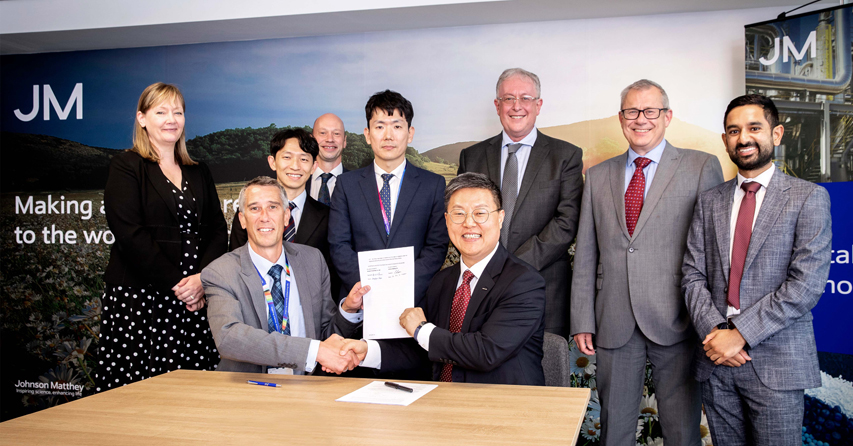Doosan Enerbility is stepping up efforts to develop ammonia cracking technology, a technology that is applicable to hydrogen-fueled combined cycle power plants. Ammonia cracking is a technology used to produce hydrogen through the decomposition of ammonia ((NH3), a compound made up of hydrogen and nitrogen, over a catalyst at high temperatures.
On July 17th, Doosan Enerbility announced that it had signed a collaboration agreement with Johnson Matthey (JM), a UK-based company specializing in ammonia cracking solutions, on pursuing joint research of the ammonia cracking business. The signing ceremony, which was held at JM’s Technology Office located in Stockton-on-Tees in northeastern England, was attended by key figures from the two companies, including Dongkyu Shin, Doosan Enerbility’s Vice President of Wind Turbine/ Service Engineering, and Phil Ingram, Johnson Matthew’s Senior Business Development Manager.* Johnson Matthey, which was founded in 1817, is a global leader in sustainable technologies. Headquartered in the UK, Johnson Matthey is an independent licensor of world-class process technologies and a developer of catalysts for industries, such as the petrochemical sector. Last year the company recorded an annual turnover of KRW 25 trillion.
With the signing of this collaboration agreement, Doosan Enerbility and JM have entered into an agreement on pursuing “Research & Development of Ammonia Cracking Technology.” JM will be engaged in the research and development of an ammonia cracker model, one that is applicable to hydrogen-fueled combined cycle power plants, until the end of this year. Under the arrangement, the two companies will be collaborating on development of the ammonia cracking process and integrated engineering of hydrogen-fueled combined cycle power plants, all of which will be available for future application in combined cycle hydrogen power generation.
Hongook Park, CEO of Doosan Enerbility’s Power Services Business Group, remarked, “The ammonia cracker model, which we are working on together with JM and which is to be applied to hydrogen-fueled combined cycle power plants, will be taking the exhaust heat generated from the initial combustion process of the hydrogen gas turbine and re-employing this in the cracker, leading to the benefit of enhanced overall efficiency of power plants.” He added, “By engaging in a partnership with JM, a partner who has a good understanding of the combined cycle hydrogen power generation model being pursued by Doosan Enerbility, we expect this will help to usher in the era of high-efficiency combined cycle hydrogen power generation.”
Doosan Enerbility is also picking up the pace for developing a high-efficiency H-class hydrogen gas turbine, a joint initiative that is being pursued with partners in the Korean industry, academia and research sectors. As part of the national project that was initiated by the Ministry of Trade, Industry and Energy (MOTIE) in 2020 for development of a high-efficiency H-class hydrogen gas turbine, the technology for 50% hydrogen co-firing is currently being developed. Once complete, it will be applied to the demonstration project at Korea East-West Power (EWP)’s Ulsan Combined Cycle Power Plant. The development of a 400MW ultra-large 100% hydrogen-fueled gas turbine is also being pursued, with the target deadline being set as 2027.
